JEEP CHEROKEE 1994 Service Repair Manual
Manufacturer: JEEP, Model Year: 1994, Model line: CHEROKEE, Model: JEEP CHEROKEE 1994Pages: 1784, PDF Size: 77.09 MB
Page 1381 of 1784
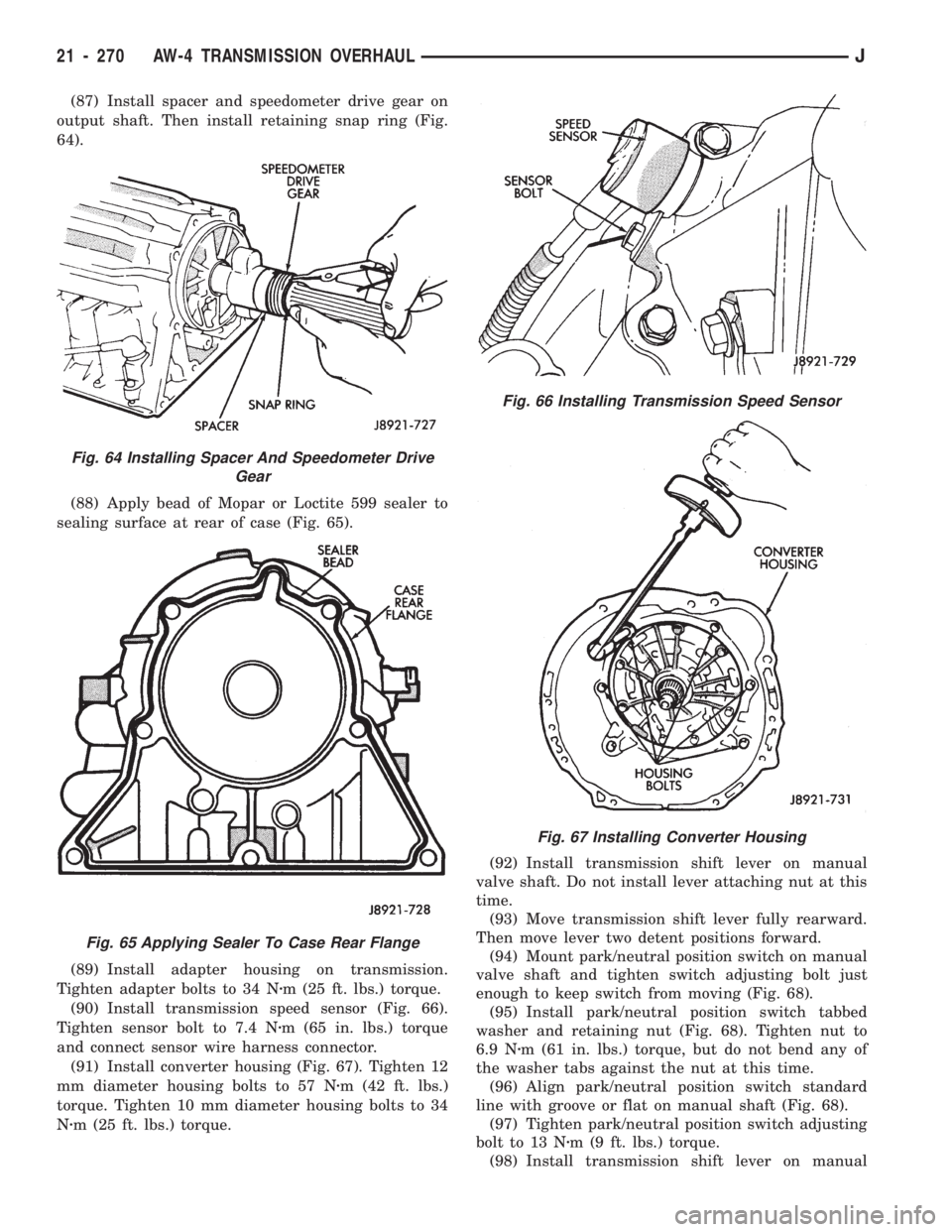
(87) Install spacer and speedometer drive gear on
output shaft. Then install retaining snap ring (Fig.
64).
(88) Apply bead of Mopar or Loctite 599 sealer to
sealing surface at rear of case (Fig. 65).
(89) Install adapter housing on transmission.
Tighten adapter bolts to 34 Nzm (25 ft. lbs.) torque.
(90) Install transmission speed sensor (Fig. 66).
Tighten sensor bolt to 7.4 Nzm (65 in. lbs.) torque
and connect sensor wire harness connector.
(91) Install converter housing (Fig. 67). Tighten 12
mm diameter housing bolts to 57 Nzm (42 ft. lbs.)
torque. Tighten 10 mm diameter housing bolts to 34
Nzm (25 ft. lbs.) torque.(92) Install transmission shift lever on manual
valve shaft. Do not install lever attaching nut at this
time.
(93) Move transmission shift lever fully rearward.
Then move lever two detent positions forward.
(94) Mount park/neutral position switch on manual
valve shaft and tighten switch adjusting bolt just
enough to keep switch from moving (Fig. 68).
(95) Install park/neutral position switch tabbed
washer and retaining nut (Fig. 68). Tighten nut to
6.9 Nzm (61 in. lbs.) torque, but do not bend any of
the washer tabs against the nut at this time.
(96) Align park/neutral position switch standard
line with groove or flat on manual shaft (Fig. 68).
(97) Tighten park/neutral position switch adjusting
bolt to 13 Nzm (9 ft. lbs.) torque.
(98) Install transmission shift lever on manual
Fig. 66 Installing Transmission Speed Sensor
Fig. 67 Installing Converter Housing
Fig. 64 Installing Spacer And Speedometer Drive
Gear
Fig. 65 Applying Sealer To Case Rear Flange
21 - 270 AW-4 TRANSMISSION OVERHAULJ
Page 1382 of 1784
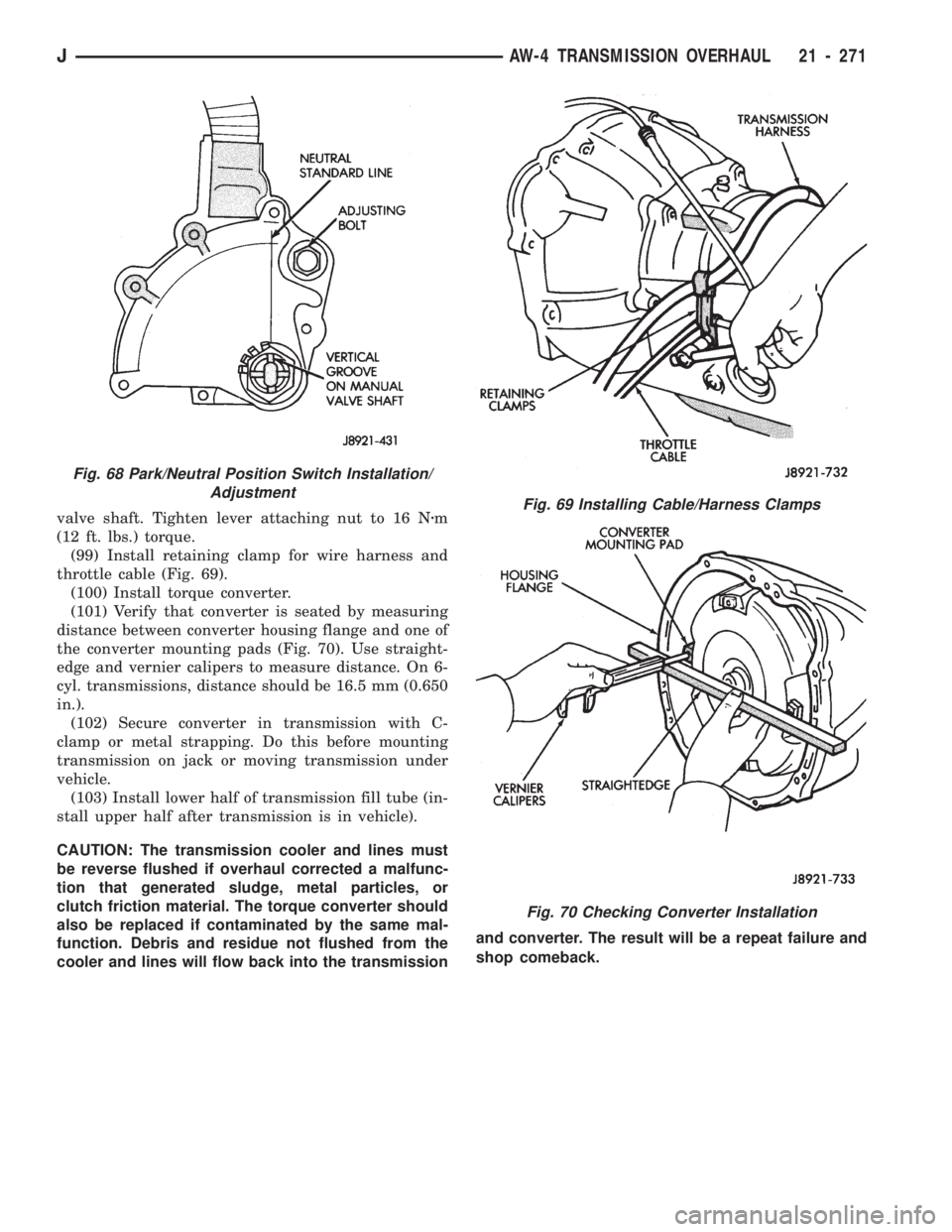
valve shaft. Tighten lever attaching nut to 16 Nzm
(12 ft. lbs.) torque.
(99) Install retaining clamp for wire harness and
throttle cable (Fig. 69).
(100) Install torque converter.
(101) Verify that converter is seated by measuring
distance between converter housing flange and one of
the converter mounting pads (Fig. 70). Use straight-
edge and vernier calipers to measure distance. On 6-
cyl. transmissions, distance should be 16.5 mm (0.650
in.).
(102) Secure converter in transmission with C-
clamp or metal strapping. Do this before mounting
transmission on jack or moving transmission under
vehicle.
(103) Install lower half of transmission fill tube (in-
stall upper half after transmission is in vehicle).
CAUTION: The transmission cooler and lines must
be reverse flushed if overhaul corrected a malfunc-
tion that generated sludge, metal particles, or
clutch friction material. The torque converter should
also be replaced if contaminated by the same mal-
function. Debris and residue not flushed from the
cooler and lines will flow back into the transmissionand converter. The result will be a repeat failure and
shop comeback.Fig. 69 Installing Cable/Harness Clamps
Fig. 70 Checking Converter Installation
Fig. 68 Park/Neutral Position Switch Installation/
Adjustment
JAW-4 TRANSMISSION OVERHAUL 21 - 271
Page 1383 of 1784
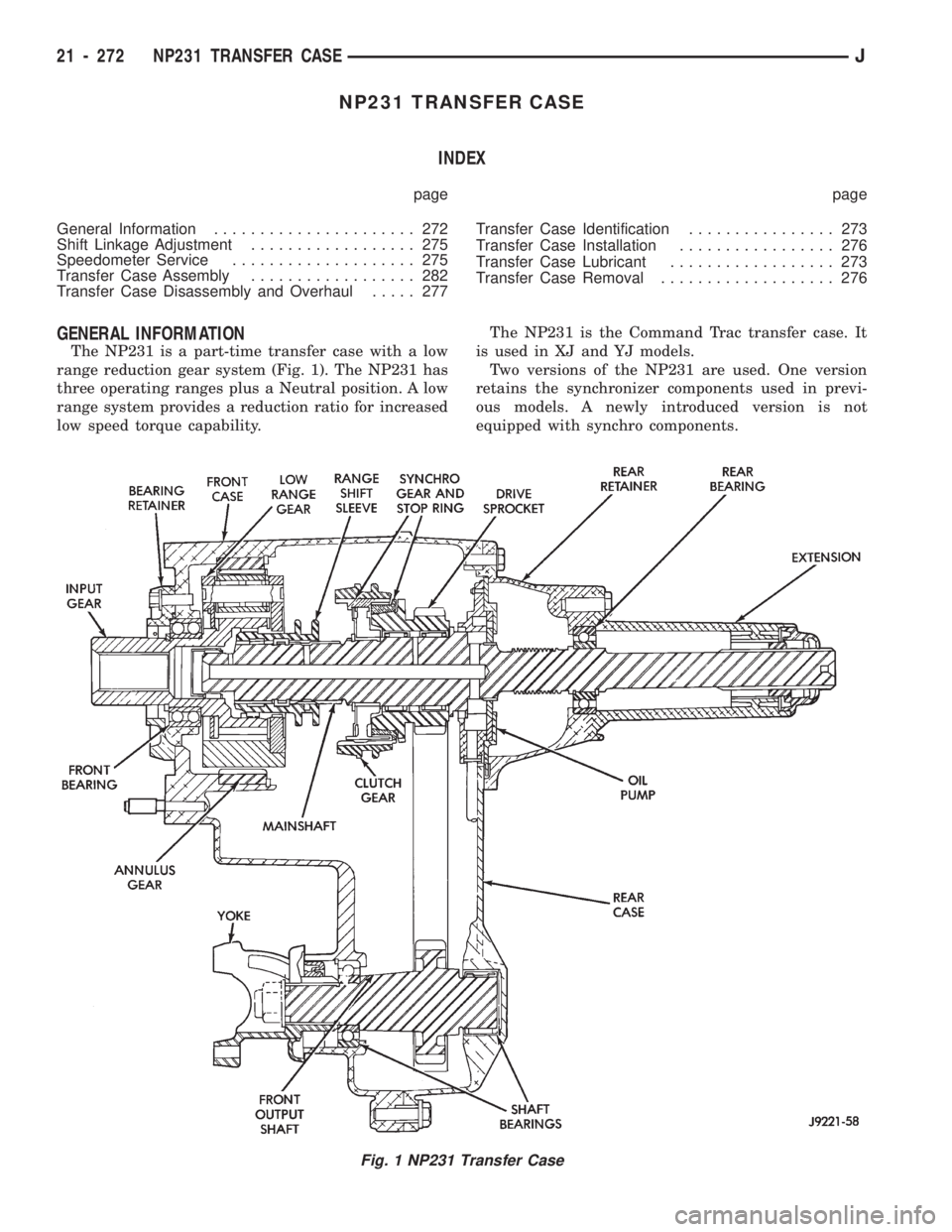
NP231 TRANSFER CASE
INDEX
page page
General Information...................... 272
Shift Linkage Adjustment.................. 275
Speedometer Service.................... 275
Transfer Case Assembly.................. 282
Transfer Case Disassembly and Overhaul..... 277Transfer Case Identification................ 273
Transfer Case Installation................. 276
Transfer Case Lubricant.................. 273
Transfer Case Removal................... 276
GENERAL INFORMATION
The NP231 is a part-time transfer case with a low
range reduction gear system (Fig. 1). The NP231 has
three operating ranges plus a Neutral position. A low
range system provides a reduction ratio for increased
low speed torque capability.The NP231 is the Command Trac transfer case. It
is used in XJ and YJ models.
Two versions of the NP231 are used. One version
retains the synchronizer components used in previ-
ous models. A newly introduced version is not
equipped with synchro components.
Fig. 1 NP231 Transfer Case
21 - 272 NP231 TRANSFER CASEJ
Page 1384 of 1784
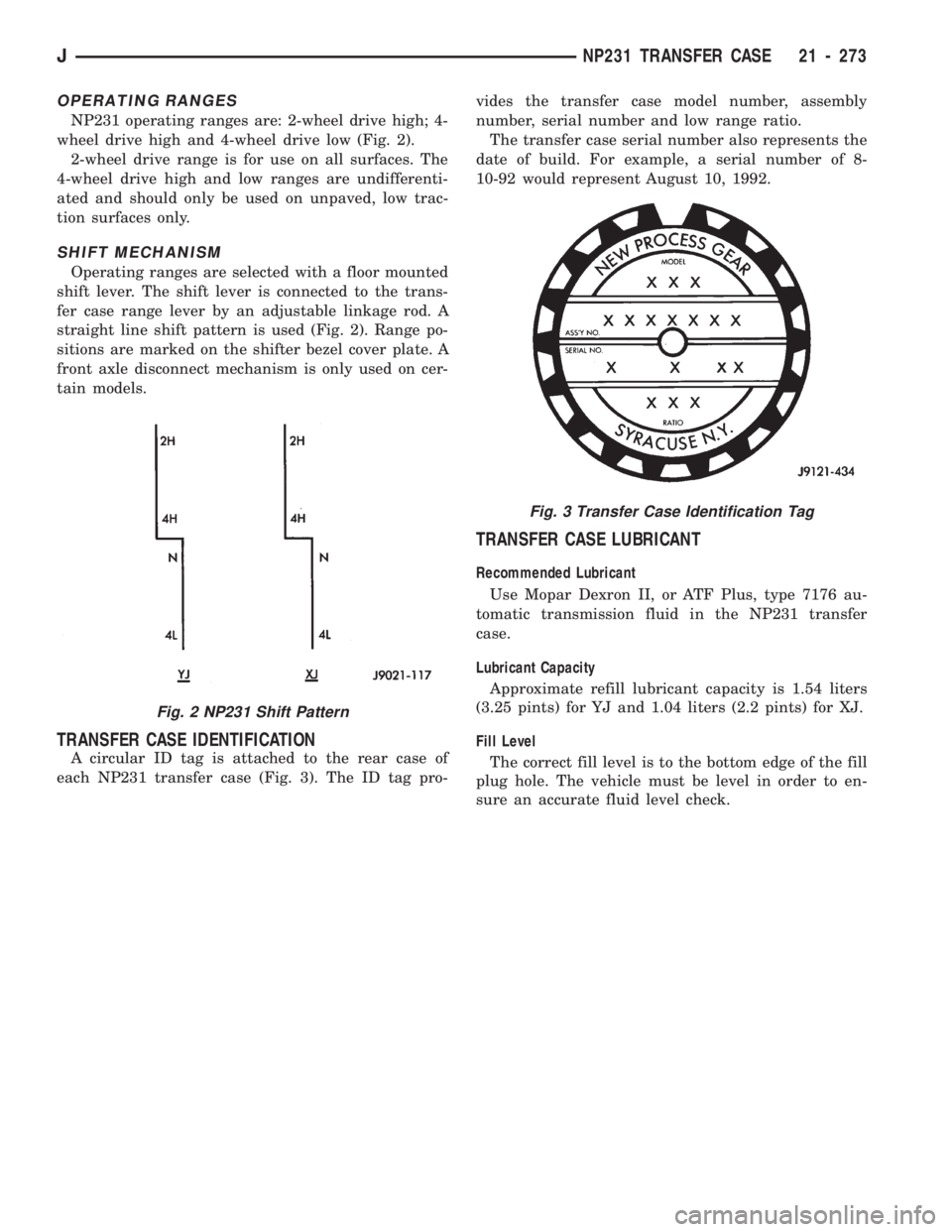
OPERATING RANGES
NP231 operating ranges are: 2-wheel drive high; 4-
wheel drive high and 4-wheel drive low (Fig. 2).
2-wheel drive range is for use on all surfaces. The
4-wheel drive high and low ranges are undifferenti-
ated and should only be used on unpaved, low trac-
tion surfaces only.
SHIFT MECHANISM
Operating ranges are selected with a floor mounted
shift lever. The shift lever is connected to the trans-
fer case range lever by an adjustable linkage rod. A
straight line shift pattern is used (Fig. 2). Range po-
sitions are marked on the shifter bezel cover plate. A
front axle disconnect mechanism is only used on cer-
tain models.
TRANSFER CASE IDENTIFICATION
A circular ID tag is attached to the rear case of
each NP231 transfer case (Fig. 3). The ID tag pro-vides the transfer case model number, assembly
number, serial number and low range ratio.
The transfer case serial number also represents the
date of build. For example, a serial number of 8-
10-92 would represent August 10, 1992.
TRANSFER CASE LUBRICANT
Recommended Lubricant
Use Mopar Dexron II, or ATF Plus, type 7176 au-
tomatic transmission fluid in the NP231 transfer
case.
Lubricant Capacity
Approximate refill lubricant capacity is 1.54 liters
(3.25 pints) for YJ and 1.04 liters (2.2 pints) for XJ.
Fill Level
The correct fill level is to the bottom edge of the fill
plug hole. The vehicle must be level in order to en-
sure an accurate fluid level check.
Fig. 2 NP231 Shift Pattern
Fig. 3 Transfer Case Identification Tag
JNP231 TRANSFER CASE 21 - 273
Page 1385 of 1784
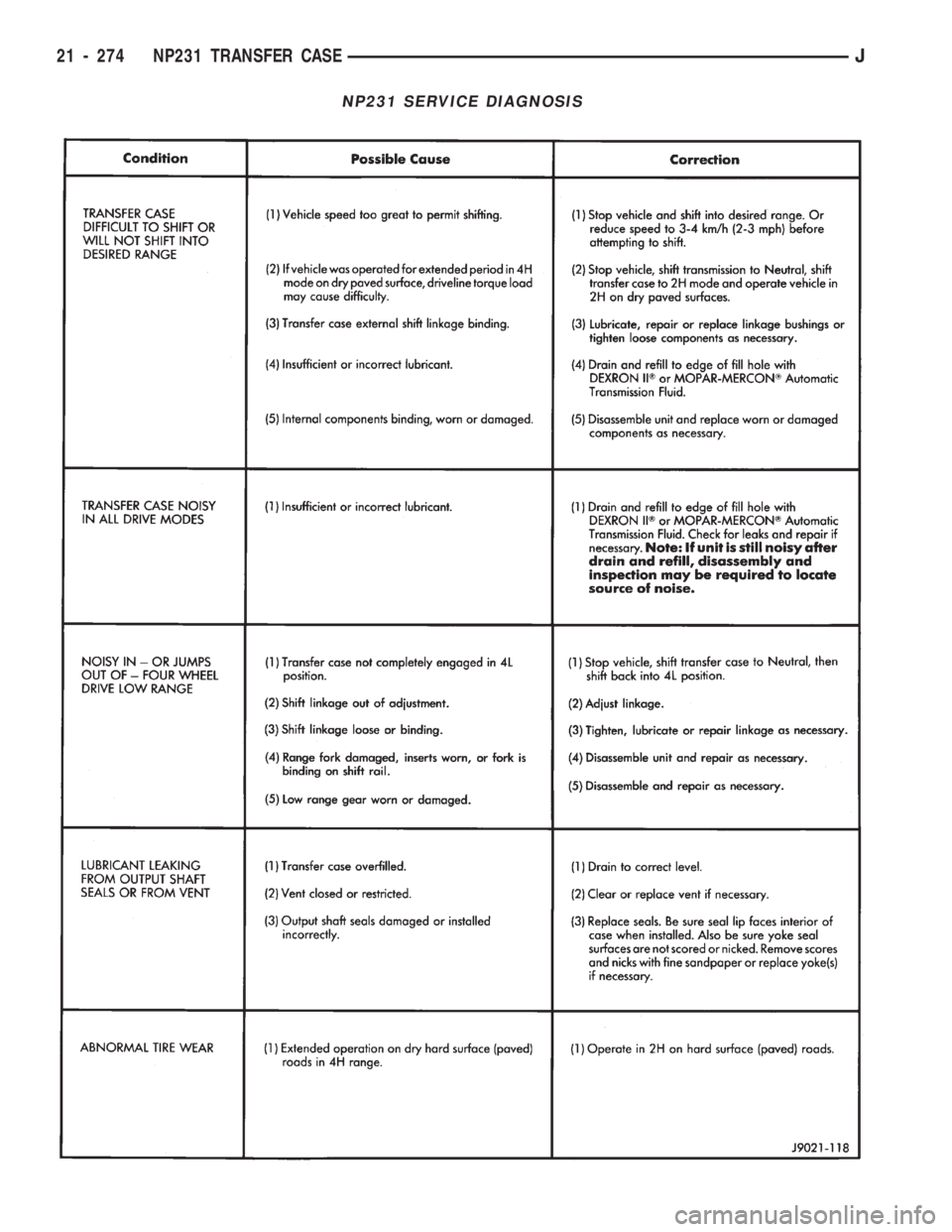
NP231 SERVICE DIAGNOSIS
21 - 274 NP231 TRANSFER CASEJ
Page 1386 of 1784
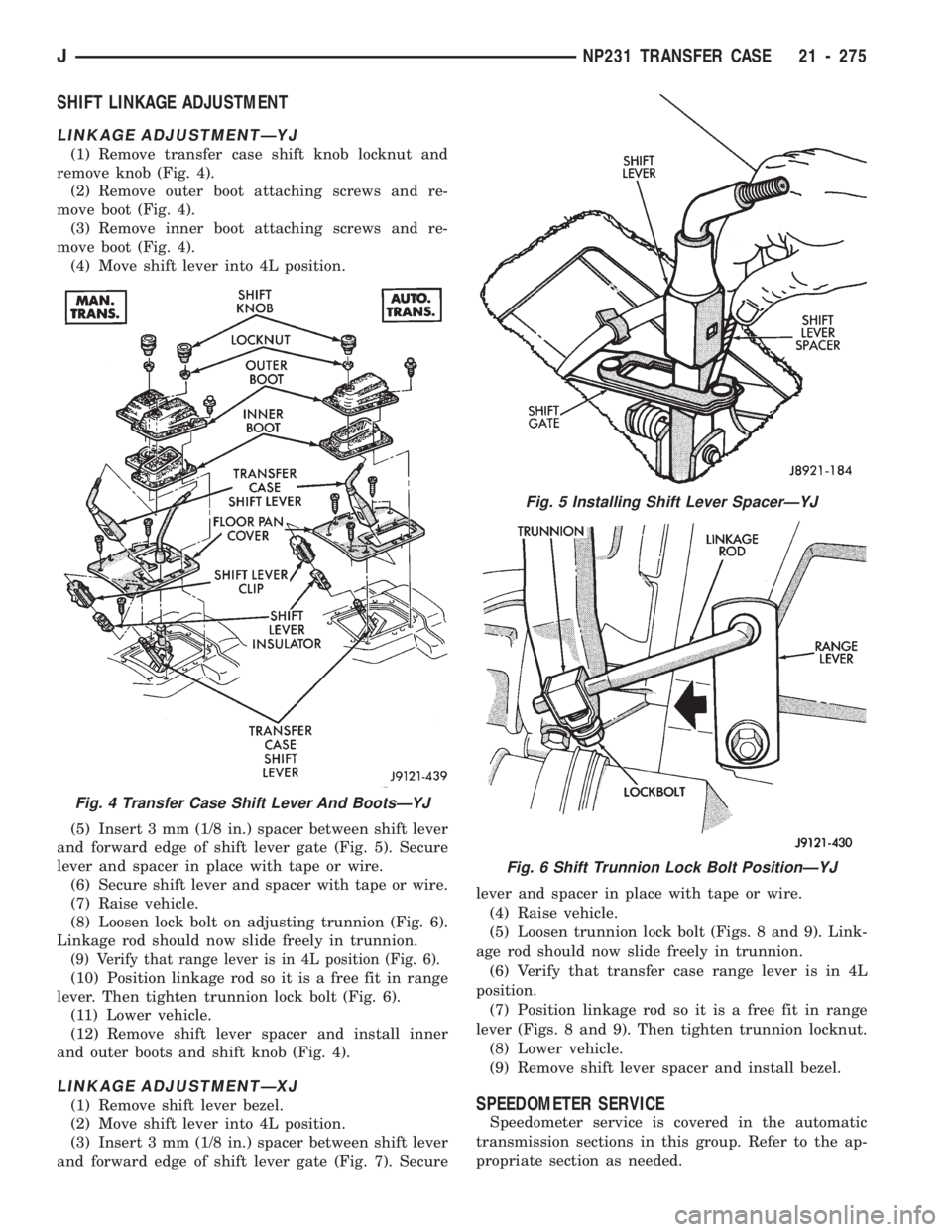
SHIFT LINKAGE ADJUSTMENT
LINKAGE ADJUSTMENTÐYJ
(1) Remove transfer case shift knob locknut and
remove knob (Fig. 4).
(2) Remove outer boot attaching screws and re-
move boot (Fig. 4).
(3) Remove inner boot attaching screws and re-
move boot (Fig. 4).
(4) Move shift lever into 4L position.
(5) Insert 3 mm (1/8 in.) spacer between shift lever
and forward edge of shift lever gate (Fig. 5). Secure
lever and spacer in place with tape or wire.
(6) Secure shift lever and spacer with tape or wire.
(7) Raise vehicle.
(8) Loosen lock bolt on adjusting trunnion (Fig. 6).
Linkage rod should now slide freely in trunnion.
(9) Verify that range lever is in 4L position (Fig. 6).
(10) Position linkage rod so it is a free fit in range
lever. Then tighten trunnion lock bolt (Fig. 6).
(11) Lower vehicle.
(12) Remove shift lever spacer and install inner
and outer boots and shift knob (Fig. 4).
LINKAGE ADJUSTMENTÐXJ
(1) Remove shift lever bezel.
(2) Move shift lever into 4L position.
(3) Insert 3 mm (1/8 in.) spacer between shift lever
and forward edge of shift lever gate (Fig. 7). Securelever and spacer in place with tape or wire.
(4) Raise vehicle.
(5) Loosen trunnion lock bolt (Figs. 8 and 9). Link-
age rod should now slide freely in trunnion.
(6) Verify that transfer case range lever is in 4L
position.
(7) Position linkage rod so it is a free fit in range
lever (Figs. 8 and 9). Then tighten trunnion locknut.
(8) Lower vehicle.
(9) Remove shift lever spacer and install bezel.SPEEDOMETER SERVICE
Speedometer service is covered in the automatic
transmission sections in this group. Refer to the ap-
propriate section as needed.
Fig. 4 Transfer Case Shift Lever And BootsÐYJ
Fig. 5 Installing Shift Lever SpacerÐYJ
Fig. 6 Shift Trunnion Lock Bolt PositionÐYJ
JNP231 TRANSFER CASE 21 - 275
Page 1387 of 1784
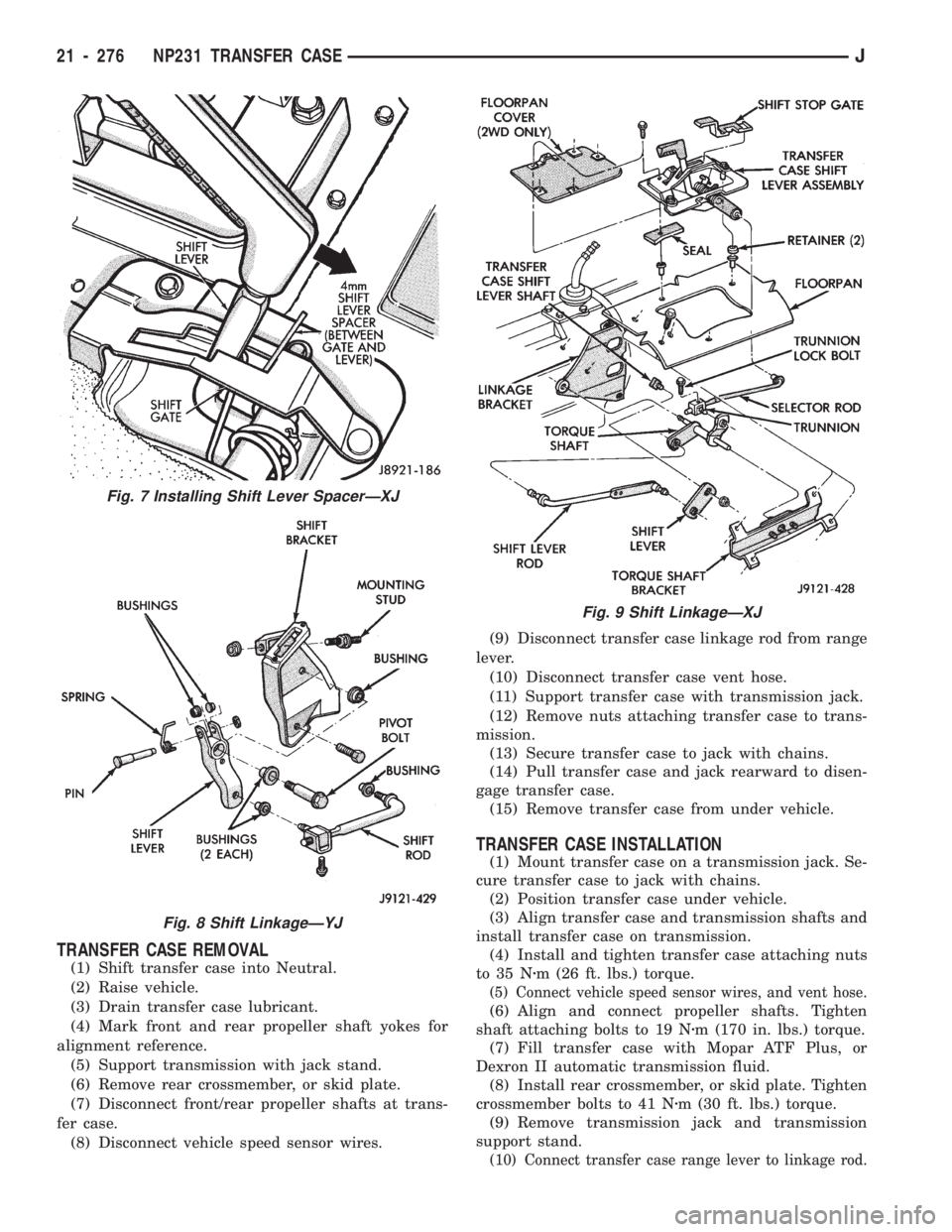
TRANSFER CASE REMOVAL
(1) Shift transfer case into Neutral.
(2) Raise vehicle.
(3) Drain transfer case lubricant.
(4) Mark front and rear propeller shaft yokes for
alignment reference.
(5) Support transmission with jack stand.
(6) Remove rear crossmember, or skid plate.
(7) Disconnect front/rear propeller shafts at trans-
fer case.
(8) Disconnect vehicle speed sensor wires.(9) Disconnect transfer case linkage rod from range
lever.
(10) Disconnect transfer case vent hose.
(11) Support transfer case with transmission jack.
(12) Remove nuts attaching transfer case to trans-
mission.
(13) Secure transfer case to jack with chains.
(14) Pull transfer case and jack rearward to disen-
gage transfer case.
(15) Remove transfer case from under vehicle.
TRANSFER CASE INSTALLATION
(1) Mount transfer case on a transmission jack. Se-
cure transfer case to jack with chains.
(2) Position transfer case under vehicle.
(3) Align transfer case and transmission shafts and
install transfer case on transmission.
(4) Install and tighten transfer case attaching nuts
to 35 Nzm (26 ft. lbs.) torque.
(5) Connect vehicle speed sensor wires, and vent hose.
(6) Align and connect propeller shafts. Tighten
shaft attaching bolts to 19 Nzm (170 in. lbs.) torque.
(7) Fill transfer case with Mopar ATF Plus, or
Dexron II automatic transmission fluid.
(8) Install rear crossmember, or skid plate. Tighten
crossmember bolts to 41 Nzm (30 ft. lbs.) torque.
(9) Remove transmission jack and transmission
support stand.
(10) Connect transfer case range lever to linkage rod.
Fig. 7 Installing Shift Lever SpacerÐXJ
Fig. 8 Shift LinkageÐYJ
Fig. 9 Shift LinkageÐXJ
21 - 276 NP231 TRANSFER CASEJ
Page 1388 of 1784
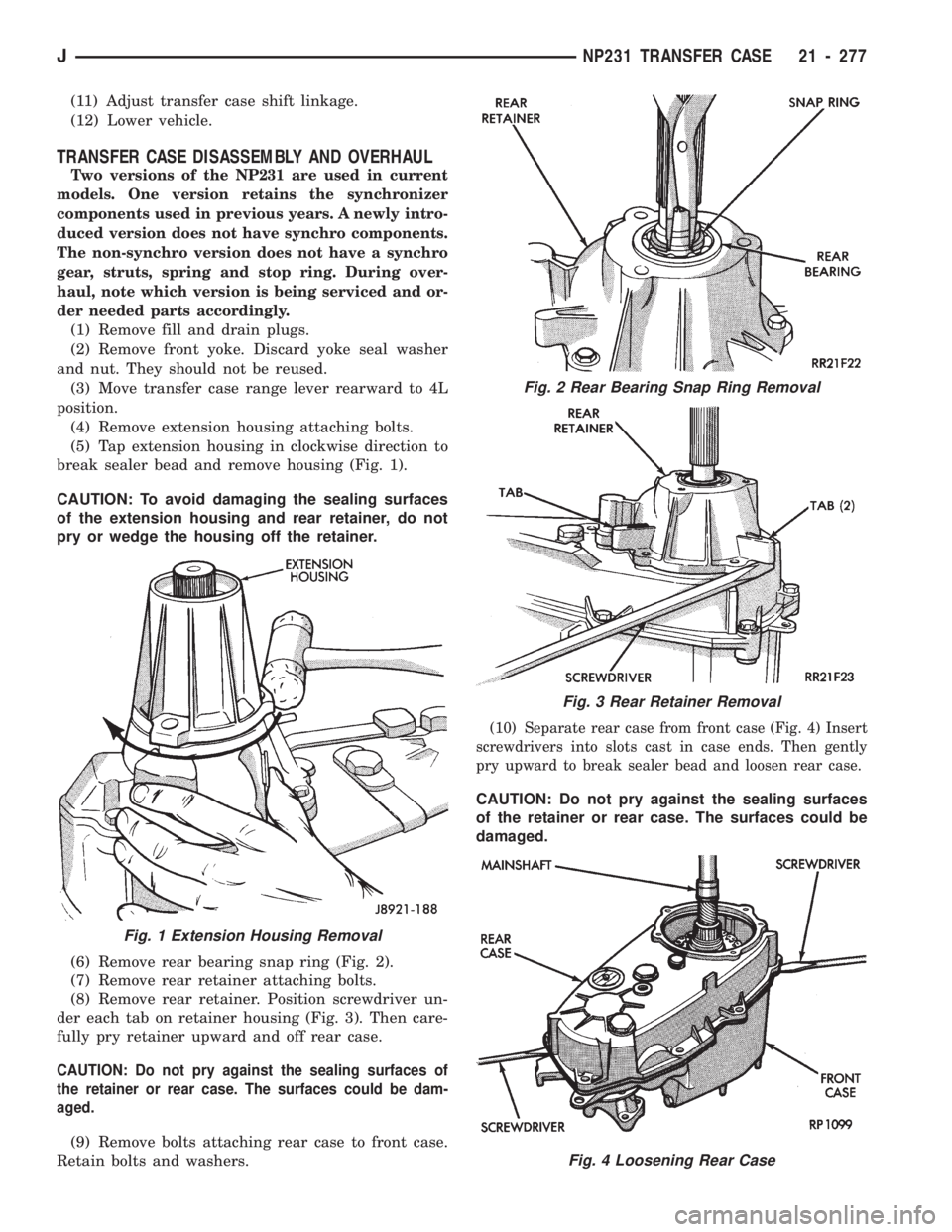
(11) Adjust transfer case shift linkage.
(12) Lower vehicle.
TRANSFER CASE DISASSEMBLY AND OVERHAUL
Two versions of the NP231 are used in current
models. One version retains the synchronizer
components used in previous years. A newly intro-
duced version does not have synchro components.
The non-synchro version does not have a synchro
gear, struts, spring and stop ring. During over-
haul, note which version is being serviced and or-
der needed parts accordingly.
(1) Remove fill and drain plugs.
(2) Remove front yoke. Discard yoke seal washer
and nut. They should not be reused.
(3) Move transfer case range lever rearward to 4L
position.
(4) Remove extension housing attaching bolts.
(5) Tap extension housing in clockwise direction to
break sealer bead and remove housing (Fig. 1).
CAUTION: To avoid damaging the sealing surfaces
of the extension housing and rear retainer, do not
pry or wedge the housing off the retainer.
(6) Remove rear bearing snap ring (Fig. 2).
(7) Remove rear retainer attaching bolts.
(8) Remove rear retainer. Position screwdriver un-
der each tab on retainer housing (Fig. 3). Then care-
fully pry retainer upward and off rear case.
CAUTION: Do not pry against the sealing surfaces of
the retainer or rear case. The surfaces could be dam-
aged.
(9) Remove bolts attaching rear case to front case.
Retain bolts and washers.
(10) Separate rear case from front case (Fig. 4) Insert
screwdrivers into slots cast in case ends. Then gently
pry upward to break sealer bead and loosen rear case.
CAUTION: Do not pry against the sealing surfaces
of the retainer or rear case. The surfaces could be
damaged.
Fig. 1 Extension Housing Removal
Fig. 2 Rear Bearing Snap Ring Removal
Fig. 3 Rear Retainer Removal
Fig. 4 Loosening Rear Case
JNP231 TRANSFER CASE 21 - 277
Page 1389 of 1784

(11) Remove oil pump and rear case as an assem-
bly (Fig. 5).
(12) Slide oil screen out of case pocket. Disconnect
screen from pickup tube and remove screen (Fig. 6).
(13) Remove pickup tube from oil pump (Fig. 6).
(14) Remove oil pump from rear case.
(15) Remove pickup tube O-ring from oil pump
(Fig. 7).
(16)The oil pump can be disassembled for
cleaning and inspection as described in steps(17) and (18). However, the pump parts are NOT
serviceable separately. If any pump component
is worn, or damaged, the pump must be re-
placed as an assembly.
(17) If oil pump will be disassembled for inspec-
tion, mark position of oil pump housings for reference
(Fig. 8). Remove screws that attach two halves of the
pump. Then remove feed housing from gear housing
(Fig. 8).
(18) Mark position of pump gears and remove
them from housing (Fig. 8).
(19) Remove mode spring (Fig. 9).
(20) Tap front output shaft upward with a rawhide
mallet to free it from shaft bearing.
(21) Remove front output shaft and drive chain as
assembly (Fig. 10).
Fig. 5 Rear Case And Oil Pump Removal
Fig. 6 Removing Oil Screen And Pickup Tube 16
Fig. 7 Pickup Tube O-Ring Location
Fig. 8 Oil Pump Components
21 - 278 NP231 TRANSFER CASEJ
Page 1390 of 1784
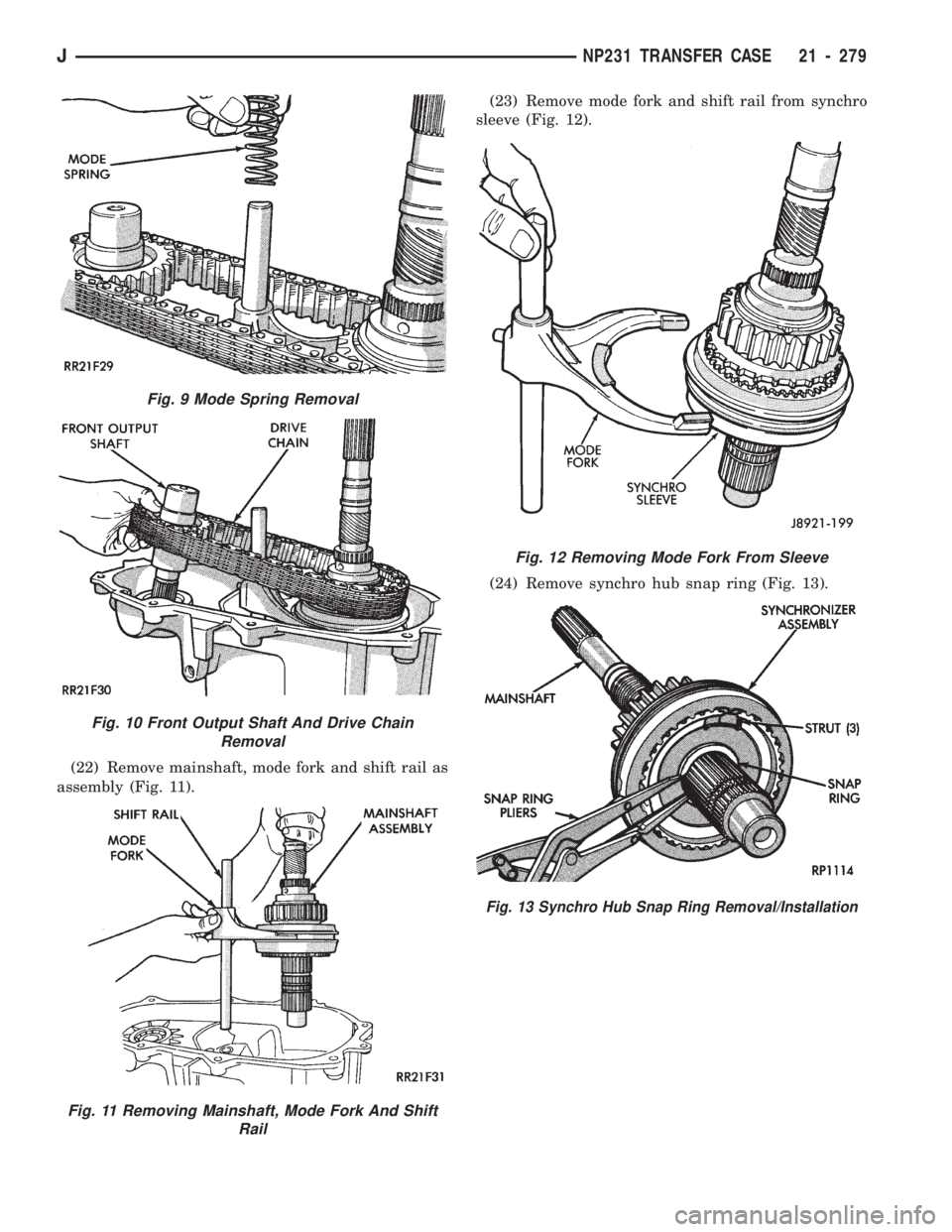
(22) Remove mainshaft, mode fork and shift rail as
assembly (Fig. 11).(23) Remove mode fork and shift rail from synchro
sleeve (Fig. 12).
(24) Remove synchro hub snap ring (Fig. 13).
Fig. 9 Mode Spring Removal
Fig. 10 Front Output Shaft And Drive Chain
Removal
Fig. 11 Removing Mainshaft, Mode Fork And Shift
Rail
Fig. 12 Removing Mode Fork From Sleeve
Fig. 13 Synchro Hub Snap Ring Removal/Installation
JNP231 TRANSFER CASE 21 - 279